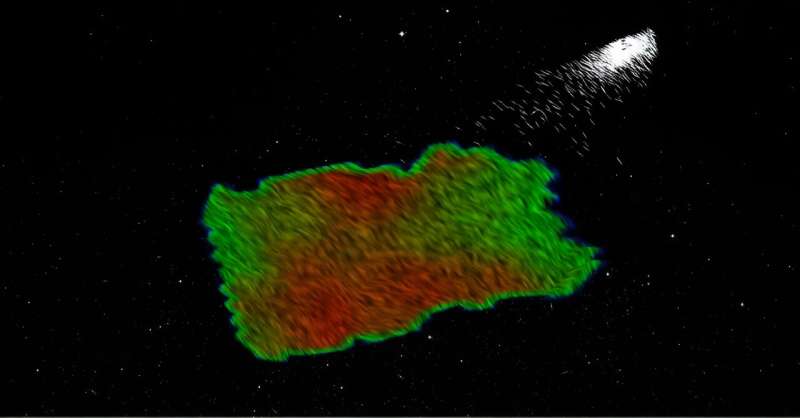Thanks to new sophisticated techniques and state-of-the-art facilities, astronomy has entered a new era in which the depth of the sky can finally be accessed. The ingredients of our cosmic home, the Milky Way galaxy—stars, gas, magnetic fields—can at long last be mapped in 3D.
The space between stars is dirty. It is filled with small dust grains, most of which are similar in size with the smoke from a cigarette. The grains are not spherical and as a result their long axis tends to align with any local galactic magnetic fields. These dust grains also emit a polarized glow in the same frequencies as the cosmic microwave background—the “ashes” of the Big Bang—thus contaminating our view of the earliest moments in the life of the universe.
They also absorb some of the starlight passing through them, much like a polaroid filter would, imprinting information about the magnetic fields within which they live on the polarization of the emerging light. Polarization is a property of light rays which indicates a characteristic direction they have, always perpendicular to the direction light propagates in space.
Magnetic fields are tremendously important for the evolution of our galaxy, regulating the formation of new stars, shaping galactic structures, and turning gas flows into cosmic accelerators more powerful than CERN.
The polarization of starlight is then the key: it holds the information on the all-important magnetic fields of the galaxy, and it is the “dust cloth” that can help us clean our view of the early universe—if only we could observe enough of it, and study it in depth, in order to extract all the information it carries.
This is exactly the scope of the PASIPHAE survey, an international collaboration between the Institute of Astrophysics of FORTH (IA-FORTH) and the University of Crete in Greece, IUCAA in India, the South African Astronomical Observatory, the California Institute of Technology in the United States, and the University of Oslo in Norway. PASIPHAE aims to measure the polarization of millions of stars over large parts of the sky. And now, we can catch a first glimpse of the capabilities of this ambitious endeavor.
A team of researchers, led by Dr. Vincent Pelgrims (past PASIPHAE postdoctoral scholar at IA-FORTH and now a Marie Curie fellow at the Inter-university Institute for High Energies at ULB in Belgium) has demonstrated the power of the PASIPHAE data and reconstruction technique using observations taken with its precursor instrument, the RoboPol polarimeter operating at Skinakas Observatory in Greece over the past 10 years.
The scientists measured the polarization of more than 1,500 stars in a part of the sky nearly 15 times the area of the full moon, combined them with distances measured for each star by ESA’s Gaia satellite, and a sophisticated algorithm they have developed, and mapped with unprecedented resolution the magnetic fields in that direction of the sky.
“This is the first time that such a large volume of the galactic magnetic field has been reconstructed in three dimensions with such fine resolution,” says Dr. Pelgrims. “We found several dust clouds in this region of the galaxy, and we were able to determine for the first time their distances—out to thousands of light years—as well as their polarimetric properties, revealing the magnetic field that permeates those clouds.”
The team is releasing this first high resolution tomographic map of the galactic magnetic field over a substantial region of the sky, which they present today (April 23) in the journal Astronomy & Astrophysics.

“This represents a great achievement toward a three-dimensional mapping of the Milky Way and its magnetic field,” says Prof. Vasiliki Pavlidou from the University of Crete and affiliate faculty of IA-FORTH and co-author of the publication. “The structure of the galactic magnetic field is currently not well constrained.
“This hampers progress in several research fields such as the study of the ultra-high energy cosmic rays. The potential of such 3D mapping to lead to breakthroughs in all domains connected to the galactic magnetic field is significant.”
“In our paper, we have only scratched the surface of the possibilities that lie ahead,” says Prof. Konstantinos Tassis, also of the University of Crete and affiliate faculty of IA-FORTH, co-author of the publication and principal investigator of the PASIPHAE project.
“Imagine such a map—but for most of the sky. This 3D atlas of the magnetic field of the galaxy will become a reality over the next few years with the help of the dedicated instruments WALOPs that will start mapping the polarization of stars in the sky this year.”
More information:
V. Pelgrims et al, The first degree-scale starlight-polarization-based tomography map of the magnetized interstellar medium, Astronomy & Astrophysics (2024). DOI: 10.1051/0004-6361/202349015
Provided by
Institute of Astrophysics
Citation:
A first glimpse at our galaxy’s magnetic field in 3D (2024, April 23)
retrieved 23 April 2024
from
This document is subject to copyright. Apart from any fair dealing for the purpose of private study or research, no
part may be reproduced without the written permission. The content is provided for information purposes only.